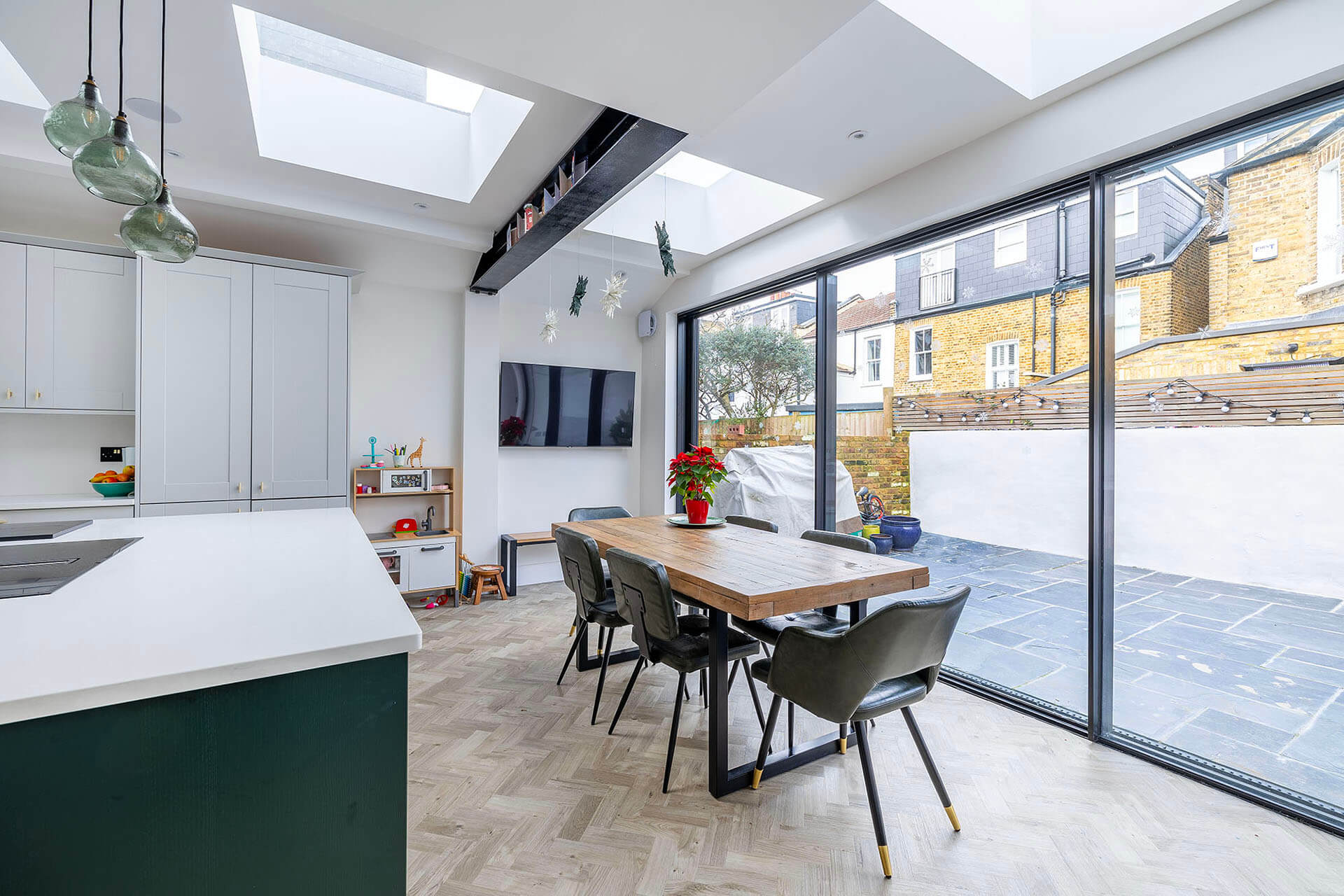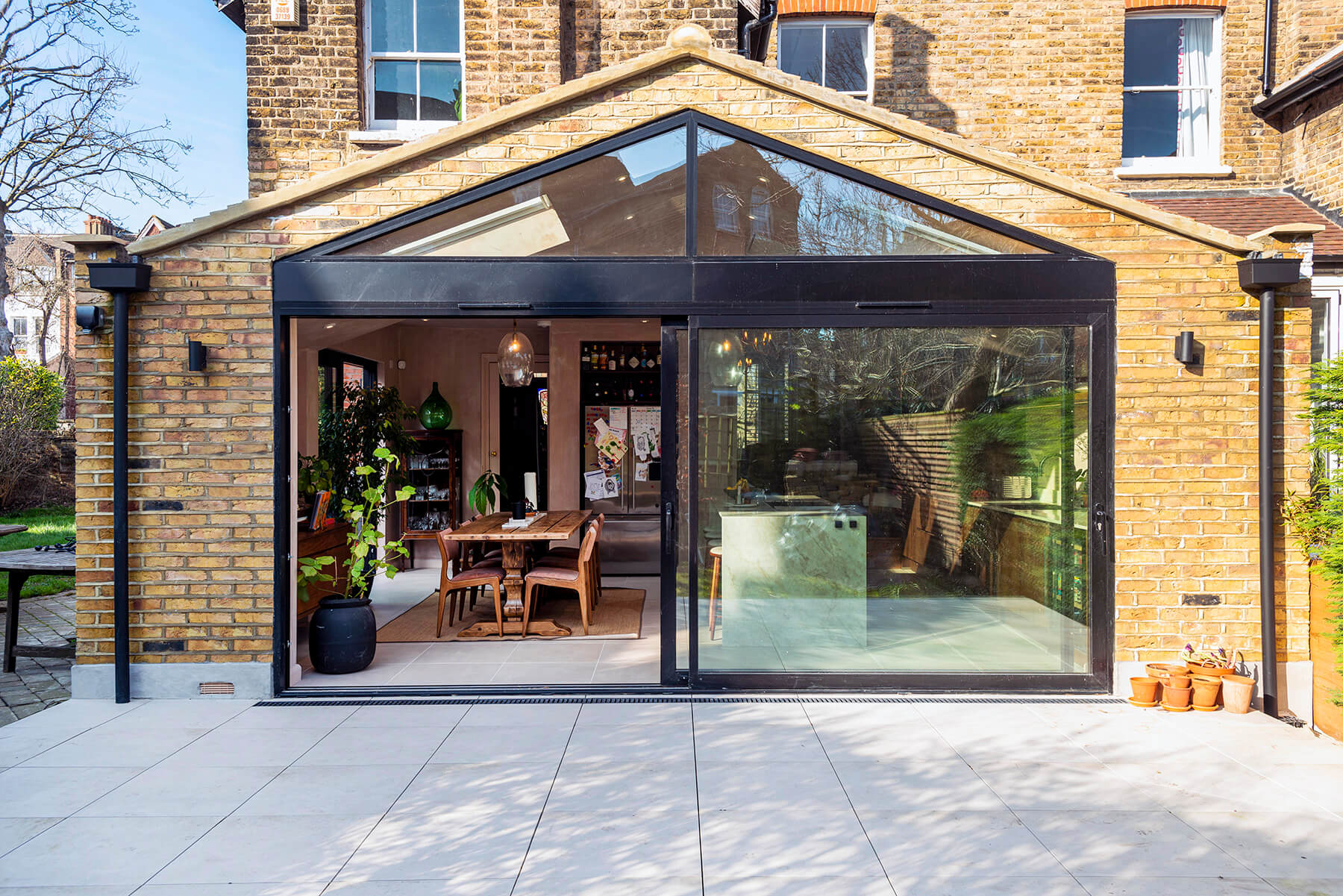The ROI of Different Extension Types: A Comparative Study
- 20-10-23
- min read
- Blog
Homeowners are always looking for ways to enhance their properties, whether for comfort, functionality, or increased value.
But do extensions still offer an excellent return on investment today?
In this comparative study, we'll explore different types of home extensions and their potential ROI based on available data.
We’ll assess various extensions, including rear (and kitchen), side return, wraparound, two-storey, and loft conversions, to help homeowners make informed decisions.
Please note, the figures here are based on external data only and don’t constitute financial advice.
Multiple sources say extensions robustly boost home value by around 10 to 25%. A few years ago, Nationwide estimated that adding a typical 30m2 extension with an extra bedroom to a 3-bed semi-detached house could boost its value by 23%.
While some of this research is now somewhat dated, the appetite for extended homes has risen, and the value created by extensions likely remains proportional when adjusted to inflation in the present day.
Of course, the housing market is prone to fluctuations, but overall, extended homes create economic value and can be profitable in both the short and long term.
Let’s take a deeper look at values for different types of extension:
A loft conversion transforms an empty attic into a functional room, typically a bedroom, office, or leisure area.
Above: Design team en-suite loft conversion project.
This extension takes advantage of otherwise unused space, providing additional living areas without altering the home's footprint. Whether it's a cosy guest bedroom or a vibrant playroom for the kids, loft conversions can add value and charm to your home.
Loft conversions have long been heralded as an optimal way to add value to a property, boasting a 70% return on investment, according to Zopa’s 2017 research.
However, this was some time ago, but aside from higher interest rates now and the impacts of inflation, there’s little reason to think that the ROI figure would be much different.
To put it into perspective, an ROI of 70% means that investing £100,000 into a loft conversion could return £170,000 – meaning £70,000 profit. This is because loft conversions typically add new rooms to a house, which significantly impact value, particularly in high-demand areas.
Here are the advantages of loft conversions:
Personalisation and Versatility: One of the loft conversion's most significant advantages is its ability to be tailored to a homeowner's specific needs and preferences. From sleek modern offices to cosy reading nooks, the possibilities are endless.
Space Optimisation: By capitalising on existing space, loft conversions can avoid consuming valuable garden or outdoor areas, maintaining the home's outdoor aesthetics.
Potential Costs and ROI: Considering the research is from 2017, we can anticipate that costs have risen due to inflation and market changes. A conservative estimate might place current average costs at around 10% to 15% higher. Even with these increased costs, the potential ROI remains attractive, given the functional and aesthetic improvements a loft conversion can bring.
Aesthetic Value: The right design and execution can turn a loft into a showcase space, marrying function with style. These spaces often become favourite areas in the home, blending utility with unique architectural features.
Rear extensions involve expanding the rear part of the property to create a larger kitchen or additional living space.
A rear extension can radically change the dynamics of the living area, creating open spaces for dining, socialising or a larger, more functional kitchen. It's popular for those seeking a more spacious and integrated living environment and offers an opportunity to build a modern open-plan space.
According to Zopa, around a quarter of home renovators opt for kitchen extensions, which yield an excellent 51% return on investment as of 2017. According to Chancellor’s, even a new kitchen without an extension boosts home value by up to 15%.
You could say that kitchen extensions are somewhat of a two-in-one, though bear in mind that installing a new kitchen adds to the cost of the extension, even though it makes sense to do both simultaneously.
Enhancing Family Life: Kitchens are no longer just places for cooking; they've evolved into multifunctional spaces where families gather, entertain, and even work. An extension can create an open-plan layout, facilitating better family interaction and enjoyment.
Planning and Execution: A kitchen extension may require significant investment and thoughtful planning. Considerations like workflow, lighting, material selection, and compliance with building regulations should be meticulously addressed.
Long-Term Value: A well-designed kitchen extension can significantly boost a home's resale value and daily living enjoyment. It's an investment in quality of life, enhancing culinary experiences, socialising, and even providing space for children's homework or creative projects.
A side return extension takes advantage of the narrow alleyway that often runs alongside a property. Side returns are widespread in Victorian or Georgian terraced and semi-detached homes.
Above: Design Team project in Clapham.
Homeowners can create a more expansive and versatile kitchen or living area by extending into this unused space.
The extension can dramatically open up a cramped space, bringing in natural light and a sense of spaciousness. It’s a relatively niche type of extension that is impactful for compact city homes.
Like other extension types, expect a ballpark increase in home value of around 10% to 25%.
Optimisation of Narrow Spaces: Many properties have narrow passages or alleys that are seldom used. Side return extensions can convert these into valuable living spaces, such as a larger kitchen or dining area.
Potential Costs and ROI: Though specific data on side return extensions is scarce, we can infer from Zopa's general extension statistics that the average profit could be around £14,000. Considering the research's 2017 date, it would be prudent to expect higher current costs, perhaps 10% to 15% more.
Versatility and Functionality: Side return extensions aren't confined to kitchens. They can add space to living rooms, create new utility areas, or even house indoor gardens.
Permits and Regulations: Proper adherence to local building codes and obtaining necessary permits is essential. Expert guidance can smooth this process, keeping your project on track.
These extensions combine the principles of both rear and side extensions, encircling part of the property in an L-shape.
Above: Design Team expansive open living project in East Dulwich.
Wraparound extensions provide multiple new spaces, from open-plan kitchens to enhanced living areas that flow seamlessly into the garden.
The blend of rear and side extensions offers a harmonious extension that can expand living areas and kitchens. It may even be possible to alter the property's configuration to add a downstairs bedroom.
Some key points:
Integrated Design Solutions: Wraparound extensions encircle part of the property, opening up possibilities for open-plan living, indoor-outdoor connections, and substantial space increases. This can create seamless transitions between the kitchen, dining room, and garden areas.
Potential Costs and ROI: Wraparound extensions are financially appealing, particularly when combined with a new kitchen or kitchen extension. They’re pricier than other extensions but can comfortably add over 40m2 of space to a home.
Careful Planning Required: Wraparound extensions can be complex, requiring careful design to maintain structural integrity and comply with building codes. Collaboration with architects and builders is often essential.
Enhanced Living Experience: By connecting various parts of the home and enhancing natural light, wraparound extensions can revolutionise the living experience. They offer opportunities to create unique features like indoor-outdoor kitchens or panoramic window walls.
Consider Your Lifestyle Needs: The comprehensive nature of a wraparound extension means it can be tailored to support specific family needs and lifestyle choices. The space can grow with the family, adapting over time.
A two-storey extension is an ambitious project that adds significant space across two levels of a home. Whether creating new bedrooms and en-suites upstairs or expanding living areas on the ground floor, a two-storey extension provides flexibility to reconfigure and expand in a way that can revolutionise the entire home.
Potential Uplift in Value: Nationwide's research indicates that a two-storey extension can add up to 23% to your property's value, at least. Considering that the figures are a few years old, it's reasonable to project even higher current gains, possibly up to 30%. This uplift reflects not just the added space but the increased versatility and luxury that can be incorporated into the home.
Investing in Lifestyle: By creating new bedrooms, en-suites, or even whole living areas, two-storey extensions can support evolving family needs or lifestyle aspirations. From guest rooms to home offices, the options are expansive.
Cost Consideration: While the investment may be substantial, the potential ROI and lifestyle enhancements make it worthwhile for many homeowners.
Expert Guidance Needed: Careful planning, design excellence, and strict adherence to building regulations are essential. Working with architects and builders who specialise in extensions ensures a cohesive design harmonising with the existing structure.
Whether adding an extra bathroom for convenience or a bedroom for growing families, these changes may be less extensive than full extensions but still provide noticeable improvements. It could also include features like a new conservatory, enhancing the property's aesthetics and utility.
Kitchens: As mentioned, new kitchens can add up to 15% to a property’s value in its own right.
Open-Plan Spaces: One study found that open-plan spaces can boost value by some 15% in their own right.
Adding Extra Bathrooms: An additional bathroom, even a compact one, can add up to 6% to your property's value, according to the aforementioned Nationwide research. The convenience and enhanced functionality can make daily life smoother, especially in a bustling family home.
Extra Bedrooms: According to Nationwide, an extra double bedroom can contribute a substantial 12% increase in value. Such a room can serve various purposes, from accommodating growing families to providing a space for hobbies or guests.
While combining different design elements with extensions, such as open plan spaces, will have a cumulative impact on value, it’d be unrealistic to think they stack and stack on top of each other
Zopa's research also highlights the trend towards long-term living in improved homes.
Some 65% of homeowners plan to stay in their extended homes for five years or more, meaning investments in extensions and improvements are not just about profit but fulfilling personal and family dreams.
However, 12% said they preferred to move soon, probably to benefit from a short-term uplift in value. Property renovators and investors can leverage extensions to make a quick profit, but this takes skill and experience.
Highlighting its 2017 research, Zopa CEO, Jaidev Janardana, said: “Home improvements can be a cost-effective way for homeowners to add value to a property for the long-term. Taking out a personal loan instead of remortgaging or using an expensive credit card, could be a smart choice for homeowners who want to spread the cost of a home improvement project over a number of years through an affordable monthly repayment and who prefer a quick and simple online application process.”
Extensions and improvements are about more than adding space; they're about enhancing lifestyles, personalising spaces, and creating long-term value.
So, while value matters, it’s important to remember that extensions create new opportunities and space without an easily quantifiable value.
In all cases, proper planning and advice are paramount. Design Team is exceptionally experienced in designing impactful, high-value house extensions that fulfil practical needs and design dreams.
With proper planning, professional guidance, and a clear vision, homeowners can realise remarkable benefits, both financially and in the quality of life.
Contact Design Team to learn more today.
Book a free Design Consultation with one of our team to discuss your project in more detail.
.jpg)
11-11-24 6

10-11-24 6

25-10-24 6